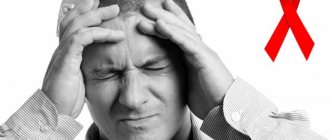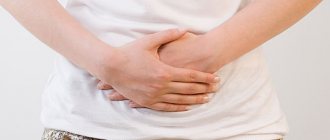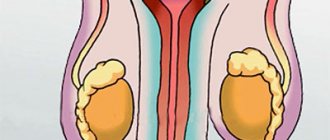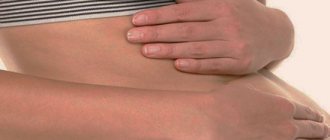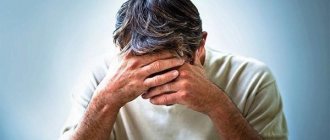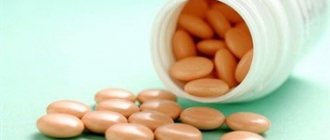Women often present with pain in the lower abdomen, but similar complaints also occur among men. If discomfort occurs suddenly, this often becomes the reason for calling an ambulance. Pain in the lower abdomen in men itself is not a specific symptom and can indicate various diseases. For a more accurate diagnosis, it is important to correctly characterize the pain itself and its location to the doctor. In men, such symptoms become a signal of the presence of a serious disease that cannot be neglected.
Anatomy of the lower abdomen in men
The male pelvis is the center of the internal organs of the reproductive and genitourinary systems.
These include:
- seminal vesicles;
- prostate gland;
- bulbous glands;
- bladder.
The male external genitalia consists of:
- from the testicles (textiles) and vas deferens;
- penis;
- urethra.
The action of the reproductive system depends on the proper functioning of the cerebral cortex, the nerve centers of the subcortex, the hypothalamus, and the anterior pituitary gland.
Male pelvis
Diseases of the digestive organs↑
The human digestive system is very vulnerable and susceptible to negative influences associated with eating low-quality food, indulgence in fatty and fried foods, spices, fast food, and sweets. All this affects the state of the gastrointestinal tract and causes intestinal disorders. In this case, the man feels heaviness in the lower abdomen, pain of various types, nausea, and flatulence.
Pain syndrome manifests itself in the following diseases:
- Proctitis.
- Ulcerative colitis.
- Hernia.
- Intestinal obstruction.
- Development of benign or malignant tumors in the intestine.
Pain may occur not due to illness, but after a heavy meal, eating difficult to digest foods, fried and spicy foods.
Pain that persists for a long time indicates a serious illness. Most often, these are pathologies of the excretory and reproductive organs, but there may also be problems with the intestines. To find out the cause of pain, you should contact a urologist or proctologist, undergo the examinations prescribed by him and follow all treatment recommendations.
In which body systems does the pathological process develop?
The cause may be an attack of infection (viral or bacterial), hormonal and chemical disorders, malignant tumors, or a hereditary factor.
The development of the pathological process is observed in the following systems:
- urinary;
- reproductive;
- digestive;
- peripheral nervous system.
Let's decipher the symptoms and causes of pain:
- Pain on the right when walking - the root cause can be muscle pathologies, pathological processes in other organs and neoplasms.
- Pain on the right when pressing – localization of pain in the area of pressing indicates the localization of inflammation. Severe pain on palpation on the right side is the main sign of appendicitis.
- Aching, nagging pain on the right side characterizes chronic pathologies.
- Cutting pain - the cause is acute processes or vascular diseases.
- Periodically occurring pain in the lower abdomen on the right is an indicator of Crohn's disease or ulcerative colitis.
- Pain in the form of contractions occurs with intestinal obstruction.
Pathologies of the urinary system
The urinary system controls the production, storage and flow of urine.
Pain syndrome in the lower abdomen is considered as a consequence of such pathologies:
- pyelonephritis;
- urolithiasis;
- cystitis;
- urethritis;
- bladder cancer.
The localization of the source of pain depends on the location of the affected organ on the right or left side.
The table will help you consider in more detail the symptoms and diseases of the urinary system:
| Disease | Etiology, description, risk factors | Symptoms and possible complications |
| Pyelonephritis | Damage to the pyelocaliceal zone of the kidneys. The nature of occurrence is bacterial. Pathogens: E. coli, pathogenic bacteria, fungi (Candida, especially), chlamydia. Routes of infection:
The acute process is characterized by a reactive course. Self-medication leads to complete kidney dysfunction. Typed according to the nature of the lesion:
And downstream:
|
change in skin color; the presence of blood clots and veins in it;
Complications include: renal failure, necrotic and ischemic processes in the kidneys (renal infarction), urosepsis. |
| UCD (urolithiasis) | KSD is the result of the formation of stones in the kidneys, urinary tract, and renal pelvis. Men of all ages are equally susceptible to urolithiasis. There are three main reasons:
It has not been reliably established due to what negative influences urolithiasis develops. There are endogenous (internal) and exogenous (external) risk factors that are likely to provoke the development of pathology:
| The nature of the pain depends (sharp, aching, pulling) depends on the size, shape, location of the stone. With renal colic - dagger-like sharp attacks in the lower right abdomen. The pain syndrome extends to the entire groin area, penis and testicles. The manifestation of an attack is caused by any physical effort, coughing, or driving on an uneven road. Nonspecific signs include:
Possible complications:
|
| Cystitis | Inflammation of the urinary tract with damage to the bladder mucosa. It occurs as a consequence of primary urological pathologies and rarely as an independent disease. According to the nature of occurrence, infectious and non-infectious cystitis are classified. During the infectious course of the disease, pathogenic agents enter the bladder from the primary source of infection. Pathogens are fungi, chlamydia, trichomonas. Very rarely occurs as a result of schistosomiasis. The causes of non-infectious cystitis are mechanical damage from stones, exposure to chemicals, thermal burns. The prerequisites for emergence and development are:
|
Complications:
|
| Urethritis | Localization of inflammation in the urethra. The main sources of triggering pathology are:
Each type of pathology has characteristic symptoms, cause of occurrence, and incubation period. Risk factors include:
|
Complications can be:
|
| Bladder cancer | The etiology is unclear. It is a malignant process with changes in the structure of the bladder mucosa. Non-invasive and pre-invasive cancers do not metastasize. Metastases do not affect organs until the third stage. Stage four cancer is incurable. There are a number of factors that may influence the development of the process:
| The first stages occur without significant symptoms. As the disease progresses, 90% of patients experience hematuria. Foci of pain are localized in the pelvic area and lower back. Other symptoms include:
Consequences include:
|
Reproductive system
The male reproductive system is a complex of internal and external genital organs. Performs reproductive function.
Among the diseases described in the sources, pain in the lower abdomen is most often caused by the following pathologies:
- prostatitis;
- BPH;
- cancer processes in the prostate gland;
- vesiculitis;
- testicular torsion;
- orchitis
Let's look at it in more detail in the table:
| Disease | Etiology, description, risk factors | Symptoms |
| Prostatitis | Genitourinary pathology. Classified:
Exposure to a pathogenic agent, coupled with provoking causes, determines inflammation of the glandular tissue. Risk factors include:
The following are considered as additional reasons for development:
There are three routes of infection:
| Manifestations of the acute form:
The chronic form does not have pronounced symptoms. Temperature is within normal limits or slightly elevated, discomfort when urinating, discharge of a small amount of mucous or purulent discharge. Dysuria syndrome is considered as a harbinger of prostatitis:
Hematuria (presence of blood) is a rare and dangerous manifestation of the disease - a sign of purulent melting of the prostate gland or a malignant form of hyperplasia. How nonspecific symptoms are considered:
How complications of the acute form of the disease arise:
The disease becomes chronic. Complications of chronic prostatitis include:
|
| BPH | Prostate adenoma (benign hyperplasia) is a small nodular formation that tends to grow. It is benign in nature. The etiology is not fully understood. Suspected risk factors include:
The most likely causes include a decrease in testosterone levels in men over 50 years of age. | The source of pain is localized in the right lower abdomen with irradiation to the back, legs, and anus. The pain is of a nagging nature, and as the disease progresses it becomes sharp, almost unbearable. Abdominal pain is a signal of ischemic processes in the prostate. Severe pain in the legs indicates damage to the entire tissue of the organ. The clinical picture depends on the phase of the disease:
Specific symptoms of the pathology include:
The consequences relate to the patient’s physical, mental, emotional health:
The result is low self-esteem, nervous breakdowns and self-doubt. |
| Prostate cancer | Prostate carcinoma is a malignant neoplasm of prostate cells. The etiology is not clear. The main risk group is representatives of the Negroid race. Atypical adenosis and hyperplasia with magnesium are considered as precancerous conditions. With adenosis, cells actively grow and multiply, a state borderline between normal and malignant process. Any impact serves as an impetus for the development of a tumor. Hyperplasia with magnesiumization is the active proliferation of cells with a change in their structure. As the disease develops, it acquires all the properties of malignancy. The risk of cancer is very high. Precursors of prostate cancer are:
Adenosis is not a guarantee of cancer, but is a serious prerequisite for it. | In the early stages it is almost asymptomatic and cannot be detected by palpation or ultrasound. In the first stages, urination is impaired, a feeling of fullness of the bladder occurs after emptying, and the volume of urine released is reduced. The pain is insignificant, occurs periodically, and is nagging in nature. Pronounced symptoms appear with metastasis. The localization of pain corresponds to the location of metastases. Often - pain in the lower back, pelvic bones and perineum. They have a pulling, aching character or appear as sharp pain attacks. Characteristic features include:
Complications include:
as a result of the action of drugs or radiation. |
| Vesiculitis | Spermatocystitis is a pathogenic process in the seminal vesicles. Develops together with orchitis, prostatitis, urethritis. The primary form occurs rarely, when affected by chlamydia, gonococci, and trichomonas. | It is characterized by pain in the pelvic and groin areas, radiating to the sacrum and lower abdomen. Specific signs include:
Complications:
|
| Testicular torsion | Inversion of the spermatic cord with impaired blood supply to the testicle. The result of the lack of normal attachment of the organ to the bottom of the scrotum. Cryptorchidism, anatomical structural features, inguinal-scrotal hernia, and excessive length of the spermatic cord are considered as causes. Additional factors include:
| It is characterized by a sudden, sharp, very severe pain in the scrotum, a sharp decrease in blood pressure. The scrotum swells and swells, its color changes to bluish. Possible complications:
|
| Orchitis | Inflammation of one or two testicles. It occurs in acute and chronic forms. It develops as a pathology accompanying infectious diseases. Most often caused by the mumps virus. Other reasons include:
| Specific symptoms include:
If left untreated, purulent processes, fistulas and hernias develop. Possible abscess. A common consequence of chronic orchitis is infertility. |
Digestive system
Complex of digestive organs, gastrointestinal tract. Carries out chemical and physical processing of incoming food and its digestion. Absorbs broken down products into the blood and lymph. Removes undigested food residues through the rectum.
Pain syndrome in the right or left lower abdomen develops as a consequence of such pathologies:
- Crohn's disease;
- irritable bowel syndrome;
- appendicitis;
- intestinal obstruction;
- colon diverticulosis;
- nonspecific ulcerative colitis;
- colon cancer.
Let's look at the table in more detail:
| Disease | Etiology, description, risk factors | Symptoms |
| Crohn's disease | Granulomatous process involving any sectors of the gastrointestinal tract. Has a tendency to relapse. The reason for the development is unclear. There are versions about the bacterial, immune and antigenic origin of pathologists. The following risk factors are identified:
| Symptoms are defined as general, local, extraintestinal. Nonspecific symptoms include fever, fever, and general weakness. Specific manifestations include:
How extraintestinal signs are considered:
In chronic cases, blood streaks or clots are present in the stool, and “drumstick” syndrome is observed. Possible complications:
|
| Irritable bowel syndrome | Characterized by impaired intestinal function. The causes of the disease are not fully understood. Factors that provoke the disease include:
| Intestinal and extraintestinal symptoms are considered:
The pathology has a chronic form, states of exacerbations and remissions are present, but malignant formations do not occur. |
| Appendicitis | Inflammation of the appendix. This is due to several reasons:
|
With peritonitis, severe non-localized pain. Vomiting appears, the skin of the face becomes marbled, and blood pressure drops sharply. Possible complications:
|
| Intestinal obstruction | Narrowing of the intestinal lumen. Complete or partial cessation of movement of its contents. The condition is not an independent form. May accompany various pathologies. There are dynamic and mechanical intestinal obstruction. It occurs as a result of adhesions, nodular formations, and strangulations in the intestines. The cause is reflex spasm of the intestines, abdominal trauma, and renal colic. A connection has been established between intestinal obstruction and damage to the nervous system. Intestinal obstruction may be a consequence of intestinal volvulus, accumulation of feces, or the formation of a ball of helminths. | Cramping unbearable pain appears in the abdomen. At the peak of the pain syndrome, the manifestations of intestinal obstruction are similar to the symptoms of shock: tachycardia appears, pressure drops sharply. Vomit. At first it is profuse, with the remains of undigested food, then vomiting with bile follows, at the last stage fecal vomit with a putrid odor appears. Other symptoms are:
|
| Diverticulosis | Formation of pouch-like protrusions of the colon mucosa. May be congenital or acquired. Develops as a result of increased intraintestinal pressure. There is a version of the connection between the formation of diverticula and a lack of plant fiber in the body. The disease can be either congenital or acquired. Prerequisites for development include:
| Symptoms do not appear for a long time. The clinical picture of uncomplicated diverticulosis is characterized by pain in the lower parts of the abdomen - from barely perceptible tingling to severe attacks in the form of contractions. The pain syndrome can be moderate or weak, but constant. Other manifestations include:
Diverticulitis is inflammation of a diverticulum. The progression of the pathology leads to peri-intestinal abscess and peritonitis. Perforation is the formation of a hole in the diverticulum with access to the abdominal cavity. The result is the development of reactive peritonitis. Intestinal obstruction - with obvious symptoms, scarlet blood (in the normal location of the diverticulum) is released in the stool. If the diverticulum is too high, the stool will become black and tar-like in color. With hidden bleeding, the only symptom is anemia. |
| Nonspecific ulcerative colitis | Diffuse damage to the colon mucosa. There are versions about the genetic, infectious, autoimmune nature of the origin of the disease. Often the primary focus of inflammation is located in the rectum. The progression of the pathology leads to its spread throughout the large intestine. The disease occurs in two phases:
| Symptoms of the acute form of the disease:
General symptoms:
There is a sharp weight loss, pain in joints and muscles. A specific symptom is inflammation of the iris and choroid. Complications include:
|
| Colon cancer | The cause is a malignant proliferation of the epithelium of the colon mucosa. How prerequisites are considered:
| The clinical picture varies depending on whether the tumor is located on the left or right side of the large intestine. Right-sided localization is characterized by:
Left-sided localization is characterized by persistent constipation, rumbling in the abdomen, and bloating. There is a change in constipation and diarrhea, impurities of blood, pus and mucus are observed in the stool. Possible complications:
Hair loss, diarrhea, weakness, nausea and vomiting develop as consequences of chemotherapy. |
Peripheral nervous system
Diseases of the peripheral nervous system include all neuropathies and neuralgia. Pain in the lower abdomen may be a sign of inflammation of the sciatic nerve.
Sciatica develops as a consequence of complications of osteochondrosis, injuries or inflammation of the joints.
The disease develops with deformation of bone tissue and degenerative processes in the spine.
Pain localized in the buttock, thigh and knee. Character – sharp, burning, cutting. A state of rest does not bring relief. Painful outbreaks may be followed by tingling, numbness or burning.
Doctors recommend!
Monastic stomach tea - for gastritis, ulcers, heartburn and for general health promotion!
Find out more>>>
Diseases of the male genital organs
Among the pathologies of the male genital organs, inflammation and neoplasms are the most common.
Prostatitis
It occurs acutely and chronically, affecting the prostate gland. The reasons are divided into:
- infectious - bacteria, viruses, fungi penetrate into the prostate tissue;
- non-infectious - arise due to impaired outflow of secretions during sedentary work, decreased immunity, and hypothermia.
Risk factors:
- hormonal imbalance during menopause;
- impaired blood circulation and stagnation in the pelvis;
- suffered injuries.
Discomfort in the lower abdomen in men with prostatitis persists constantly and manifests itself as a dull pain.
Prostatitis pain radiates to the scrotum, perineum, anus, sacrum
Additional signs:
- urinary retention, painful frequent urges;
- burning sensation in the urethra when urinating;
- slight increase in temperature with chilling;
- headache, joint, muscle pain;
- causeless fatigue;
- constipation or painful bowel movements;
- decreased erection, defective sexual intercourse;
- pain in the head of the penis after intimate life.
When examining sperm, a violation of the composition and qualitative changes are detected.
Diagnostics
Diagnostics includes medical history, physical, instrumental, and laboratory examination methods:
- Anamnesis collection. A well-collected medical history helps to avoid additional procedures and prescriptions. Allows you to make initial conclusions about the nature of the pathology. Includes two sections: life history;
- medical history.
- examination allows you to determine the condition of the skin, lymph nodes, accessible mucous membranes;
- general and biochemical blood test;
- Ultrasound (sonography) using ultrasound scanners; has a number of advantages: no radiation, mobile, accessible, does not require the use of contrast agents; The Doppler method is used as a type of ultrasound.
The main causes of pain on the left side of the lower abdomen
Pain in the lower abdomen on the left side is a reason to consult a doctor
Feelings of pain in the abdominal area are usually a sign of a developing pathology. What actions should be taken if the lower abdomen hurts on the left side?
Of course, do not delay treatment and seek the help of a specialist. Only a doctor, after an examination, will determine the root causes of deterioration in health.
To make a diagnosis, the doctor needs to find out not only the location of the pain, but also its nature, intensity and duration.
There are several distinct types of pain:
- dull, aching;
- pulling;
- sharp (sharp);
- piercing.
Let's consider the possible causes of various types of pain localized in this area of the peritoneum.
Dull, aching pain
Pain in the lower abdomen on the left side
May signal defects in the stomach and pancreas. Often, nausea and vomiting appear along with it, and body temperature rises. If such conditions occur, you should immediately contact a medical facility.
As a rule, aching pain occurs with various gynecological pathologies of the ovaries and uterus. Unpleasant sensations can appear both during physical activity and at rest, and are supplemented by blood discharge from the genitals.
In addition, such painful sensations in some situations are a sign of chronic cystitis, inflammation of the hemorrhoidal vein, varicose veins, tumors, defects of the sigmoid and rectal intestines.
Nagging pain
Nagging pain of low intensity is a companion to inflammatory and purulent pathologies of the genitourinary organs, parts of the intestine (sigmoid, rectum) and spreads to the left leg and lower back.
They often talk about the presence of a strangulated hernia, as well as irritable bowel syndrome, which is accompanied by cramps, constipation or diarrhea, bloating and other symptoms.
Acute (sharp) pain
Pain in the lower abdomen on the left side: palpation
Unbearably strong, sharp pain may be a sign of:
- colitis;
- cystitis;
- urolithiasis;
- inflammation in the gastrointestinal tract resulting from exposure to infections (dysentery, salmonellosis, gastroenteritis, etc.);
- adnexitis;
- ectopic pregnancy;
- oncological formations in the last stages of disease development.
Stitching type pain
A stabbing type of pain appears in various pathologies of the kidneys and intestines and accompanies the passage of kidney stones through the left ureter.
The appearance of unpleasant sensations of this type also indicates inflammation of the lumbar region, hip joints and cartilage.
Types of treatment for lower abdominal pain
For pain in the lower abdomen, the following types of treatment are used:
- Relieving acute pain with medications: relieve spasms, reduce fever and fever, dilate blood vessels, the disease itself is not treated. These drugs include: No-shpa, Papaverine, Spasmomen. Pharmaceuticals from the NVP group are used as antipyretic, anti-inflammatory and analgesic agents. During severe pain due to metastatic malignant tumors, powerful analgesics or narcotics are prescribed.
- Treatment with antibiotics. Medicines are of natural or semi-synthetic origin. They belong to different groups, each of which has a detrimental effect on a certain type of microbe. Use strictly as prescribed by a doctor.
- Endoscopic treatment. Includes: cystoscopy - a procedure used to crush small stones. Stop bleeding and remove small tumors.
- colonoscopy – indication is any pathology of the colon; does not require general anesthesia.
Characteristics of unpleasant sensations
The nature of the discomfort felt is important information in the process of identifying diseases. Painful sensations in the lower abdomen can be:
- stupid;
- aching;
- sharp;
- piercing;
- "dagger";
- pressing;
- pulling.
Pain of mild to moderate intensity indicates the onset of the inflammatory process. Lack of treatment leads to increased pain, transforming it into acute and cramping pain. This indicates that the problem is getting worse.
Obvious malfunctions in the functioning of organs and disruption of their blood supply are manifested by intense pain. It occurs with extensive tissue inflammation and the development of purulent-necrotic processes. Acute cramping pain is a consequence of spasm of hollow organs consisting of smooth muscle muscles. Pulsating discomfort manifests itself as changes in pressure inside the cavities and disruption of the blood supply to tissues. Sharp, “dagger” pains are a signal of damage to the capsular organs or perforation of the walls of the cavity structures. Diffuse intense pain without a specific localization is a consequence of developing peritonitis. This condition threatens human life.
It is necessary to describe to the doctor as accurately as possible the nature of the pain syndrome, the place and time of its occurrence, whether it has become stronger or weaker.
Knowing all aspects of the clinical picture, the doctor will quickly diagnose and prescribe the correct treatment. Pain in the lower abdomen may be accompanied by:
- changes in the general condition of the body (weakness, drowsiness, increased fatigue, irritability, dizziness, headaches);
- digestive disorders (lack of appetite, nausea, vomiting, bloating or heaviness in the abdomen when they appear - before or after eating);
- changes in the nature of bowel movements (when was the last stool, its character, impurities in feces and urine, how painful is urination and defecation);
- other changes (changes in the quality and regularity of sexual activity, sensations during sexual intercourse and ejaculation, the appearance of impurities in sperm);
- reflected pain (where the discomfort radiates - to the perineum, lower back, thigh, groin, leg, side, center of the abdomen).
The man must voice all the information collected at the first meeting with the doctor. The correctness of the diagnosis depends on this.
Diet therapy
Pain in the lower abdomen is caused by various reasons, one of them is intestinal diseases.
A well-chosen diet normalizes stool, relieves pain, and alleviates general condition.
It is recommended to exclude salty, spicy, fatty foods.
Depending on the disease, some products of plant origin (legumes, nuts, raw cabbage, bananas, plums) are also excluded.
For any pathologies, it is recommended to consume mineral water, green tea, herbal teas, and fermented milk products.
Overeating is avoided; food should be taken in small, fractional portions.
Left-sided pain in the iliac region
Pain in the left lower abdomen due to gastrointestinal diseases
Left-sided pain in the lower abdomen can be observed with such pathologies as:
Colitis , in which, in addition to aching pain in the lower abdomen, the following are observed:
- false urge to have a bowel movement;
- flatulence;
- diarrhea, sometimes with mucus and blood.
With nonspecific ulcerative colitis, not only inflammation of the walls of the colon is observed, but also ulceration of the mucous membrane, in which, in addition to the symptoms described above, the following signs may appear:
- heat;
- weakness;
- loss of appetite;
- weight loss;
- arthralgia;
- violation of water-salt balance.
Intestinal obstruction . Its earliest manifestation is pain in the abdomen; it occurs regardless of food intake and can appear unexpectedly at any time of the day or night. They are of a cramping nature. As the pathology progresses, they usually subside within 48-72 hours, but this is a dangerous symptom.
Also observed:
- constipation;
- bloating and asymmetry of the abdomen;
- nausea and repeated vomiting.
Also, pain in the left lower abdomen can be observed with intestinal cancer . They are usually blurred and weakly expressed, but still they are constant and not associated with food intake.
In addition, there are:
- constipation;
- bloating and rumbling in the intestines;
- blood in the stool.
Left-sided pain in the lower abdomen in diseases of the female reproductive organs
Pain in the lower abdomen on the left side can be observed with diseases of the female genital organs, such as:
- inflammation of the appendages, with which pain can be observed not only in the lower abdomen, but also in the groin and lumbar region; in addition, there may be an increase in temperature, asthenia, cephalgia, myalgia, problems with urination; chronicity of the disease is characterized by dull pain in the left side, groin, in the vagina, menstruation and sexual function disorders;
- torsion of an ovarian cyst, in which, in addition to severe pain, a disturbance in general health, hypotension, fever, and vomiting are observed;
- ectopic pregnancy, which can cause rupture of the oviduct or ovary, resulting in sharp, unbearable pain.
Important! If an ectopic pregnancy is terminated, urgent hospitalization is required, since in this case there is a threat to the patient’s life.
Pain in the left side behind can be observed with heart disease. This sign is most often characteristic of myocardial infarction, although it can also be observed with angina pectoris, enlargement of the aorta, and pericarditis. With myocardial infarction, there is a sharp pain in the heart, which extends to the left shoulder blade, side, upper limb, and neck. In addition, the following appears:
- cold sweat;
- nausea;
- dyspnea;
- dizziness;
- pre-fainting state.
In addition to pain in the left side during myocardial infarction, cold sweat may be observed
Conditions that require emergency assistance
The nature and frequency of occurrence of pain syndrome is determined:
- A dangerous sign - stabbing pain - is a sign of appendicitis or peritonitis; calling an ambulance is necessary. Before she arrives, place a heating pad with ice on your stomach.
- Emergency care is called for persistent pain that does not go away for 2 hours or more. This is a possible sign of acute appendicitis. The patient is not given painkillers and is not allowed to take water or any food. An ice pack is placed on the stomach.
- The same manifestations occur when an inguinal hernia is strangulated. At the same time, they provide the patient with bed rest, do not give painkillers, and do not try to repair the hernia on their own.
- Calling an ambulance is mandatory in case of intestinal bleeding, the signs of which are bloody vomiting, stool has the color of tar and a pungent odor. Place an ice pack, and if you lose consciousness, bring cotton wool soaked in ammonia. They do not give food or water, and the stomach is not washed.
Doctors recommend!
Monastic stomach tea - for gastritis, ulcers, heartburn and for general health promotion!
Find out more>>>
Atypical location of the inflamed appendix
With appendicitis, pain is most often determined on the right, but in rare cases the pain shifts to the left. Symptoms of the pathological condition are:
- initially moderate intestinal spasms, intensifying over time - the pain becomes cramping and throbbing;
- nausea ending in vomiting;
- diarrhea (relatively rare);
- increase in body temperature.
Soreness in the lower left abdomen in men may indicate the development of serious illnesses. And if pathological symptoms appear, it is recommended to obtain qualified medical advice.
FAQ
Why:
- Do men experience pain in the lower abdomen after sexual intercourse? Symptoms of prostatitis, prostate adenoma, sexually transmitted diseases.
- Do men experience pain in the lower abdomen when urinating? The first manifestations of cystitis, prostatitis, adenoma.
- Do men experience pain in the lower abdomen after eating? Irritable bowel signal. They occur when overeating, suffering from stress, after drinking strong drinks, smoked, spicy foods.
What specific male organs are the culprits of pain?
The cause of pain in the lower abdomen in men can be diseases of the genital organs (prostate and seminal vesicles). They are located in the pelvic cavity, and not in the abdomen. But there is severe pain below the navel.
The prostate or prostate gland lies inferior to the bladder and anterior to the rectum, surrounding the urethra. Produces seminal fluid. During an erection, it blocks the flow of urine and throws secretions into the urethra. The activity is closely related to the function of the endocrine system (including the testes, adrenal glands).
The seminal vesicles are located above the prostate gland in the middle. This is a paired organ that produces secretions to support sperm viability. Older patients experience difficulty urinating and inflammation caused by stagnation. Violation of secretion production in the seminal vesicles of a young healthy guy makes him childless.
Under the influence of age-related hormonal changes in men, the prostate grows (benign hyperplasia), it compresses the urethra with its size and promotes urinary retention
To find out why the lower abdomen hurts in men, it is necessary to examine all internal and external genital organs: testicles, seminal vesicles, prostate, urethral glands, vas deferens, scrotum and penis. Pain in the lower abdomen has its own characteristics. We will consider their diagnostic value for the most common diseases.
Musculoskeletal diseases
It happens, often after excessive physical exertion, prolonged movement, or climbing to a height, that a sharp pain occurs in the left side, which forces a person to literally freeze in one position.
Such discomfort is often a consequence of diseases of the musculoskeletal system:
- arthrosis;
- rheumatoid arthritis;
- scoliosis;
- gout;
- rickets;
- coccydynia (disturbances in the coccyx area);
- tumors;
- congenital anomalies.
When a nerve is pinched as a result of such disorders, pain can occur in any segment of the body. The nerve can be pinched at the top in the neck or back, or at the bottom, near the thigh, and the pain will be on the left side of the peritoneum.
With scoliosis of the spine, the nerves responsible for the gastrointestinal tract are pinched. Therefore, in addition to discomfort in the left side (if a nerve is pinched, it is quite strong), pain occurs in the stomach, intestines, and sometimes near the heart.
Why does my stomach hurt?
The causes of pain are very diverse - most of them are relatively harmless. But there are also serious diseases that manifest themselves through abdominal pain. It is important to recognize when you need to see a doctor immediately.
Pain can be caused by changes in intraintestinal pressure in the small and large intestines, stretching of the lumen or contraction of the muscularis propria, as well as disturbances in the blood supply.
Abdominal pain should be distinguished by the following symptoms:
- how long does the pain last,
- type of pain
- what area of the abdomen hurts?
- to which areas of the body it irradiates (gives or spreads).
Depending on the duration of the pain, there are:
- acute - acutely occurring, which recurs after some time,
- chronic - persistent abdominal pain for several weeks, which may either increase or decrease,
- chronically recurrent - over a long period of time they either appear or are absent.
Acute abdominal pain that appears suddenly is quite common, for example due to a gastrointestinal infection or stress.
Chronic persistent abdominal pain occurs in rare cases.
Chronic pain with relapses is much more common. They are characteristic, for example, of irritable bowel syndrome or chronic inflammatory bowel diseases such as Crohn's disease.
The abdominal cavity contains a large number of internal organs. These are primarily the digestive organs, in women the uterus and ovaries, in men the prostate gland. Problems with any of these organs can cause abdominal pain.
The heart and lungs are also in close proximity to the abdominal cavity, and their diseases can cause abdominal pain.
Conventionally, pain in the abdominal cavity can be divided into three groups:
- pain in the intestines,
- pain in other abdominal organs,
- pain that has no connection with the abdominal organs.
If your left side hurts
Pain in the left side of the abdomen often occurs after overeating or eating unhealthy foods. Stress and overwork can also cause pain in the intestines. In this article we will look at diseases that lead to left-sided pain in the iliac region, in the hypochondrium of the abdomen and in the lower abdomen on the left.
1 - left lobe of the liver
2 - pancreas
5 - large intestine
6 - small intestine
9 - upper hypochondrium
Pain throughout the abdominal area
Sometimes it can be difficult to pinpoint the location of abdominal pain. Possible causes of such pain include:
- gastrointestinal infections,
- stress,
- peritonitis,
- circulatory disorders,
- intestinal obstruction.
Acute stomach. This is a sign of a medical emergency and requires an urgent call to the ambulance. Typical symptoms include a hard stomach, pressing pain, sweating and a weak pulse.
For more information on the topic of abdominal pain, see the following articles:
The appearance of throbbing and cramping pain
Cramping pain occurs with infections in the genitourinary system. Throbbing pain is usually associated with intestinal obstruction and malignant neoplasms.
Prostate cancer
Usually diagnosed in men suffering from adenoma, prostatitis and chronic inflammation of the genitourinary system.
Provoking factors:
- elderly age;
- heredity;
- hormonal disorders;
- progression of adenoma.
The main signs of the disease in the early stages of development:
- Frequent urge to urinate.
- Interruption of urination, weak stream.
Later, when cancer metastasizes, the following symptoms are noted:
- weakness;
- pain in the spine;
- sudden weight loss.
In addition, there is a stabbing pain in the sternum.
Nonspecific ulcerative colitis
An illness of unknown nature occurs with damage to the lining of the large intestine.
Factors contributing to the development of pathology are:
- nicotine intoxication;
- heredity;
- influence of antibiotics;
- reduced immunity.
The patient suffers from painful cramping sensations that intensify after eating.
In addition, the disease is accompanied by:
- frequent loose stools;
- decreased appetite;
- sudden weight loss;
- increased temperature;
- intestinal bleeding.
Blood, purulent or mucous impurities may appear in the feces.
If men experience pain in the lower left abdomen, they should consult a doctor to determine the root causes of their development. Most often, discomfort accompanies pathologies of the genitourinary system or malignant neoplasms. Constant pain indicates chronic diseases of the pelvic organs. Lack of timely treatment can lead to the development of dangerous complications.
Pain in the left lower abdominal segment in men can be caused by various reasons. Anatomically, the sigmoid and rectum are projected in this area. In addition, inflammation of the prostate gland, spleen, and renal colic can cause pain.
Location of organs in the abdomen
| Location | Internal organs |
| Right side of the lower abdomen |
|
| Left lower abdomen |
The difficulty of making a diagnosis in men lies in the fact that their pathologies of the abdominal and genitourinary organs have the same symptoms. It is important to understand the disease, prescribe the correct treatment, this is done by specialists; self-diagnosis is unacceptable.
Knowing the location of internal organs will allow you to quickly understand the possible causes of illness. Diseases of the abdominal organs have their own distinctive features; knowing them, you need to manage the information correctly: not make diagnoses yourself, but understand what measures to take to avoid the appearance of pathologies.
Preventive measures
To prevent the infection from entering the body and causing intestinal upset, you must first wash your hands, vegetables and fruits. In hot countries, drinking water in unfamiliar places is prohibited. To avoid ending up in a middle-class hospital where they cannot provide the necessary medical care, you need to be careful with what you eat.
People whose parents or other close relatives have had cancer or genetic diseases are advised to undergo medical examinations more often. This will allow timely detection of the malignant process and treatment.
With frequent sexual intercourse, it is necessary to use barrier methods of protection so as not to provoke acute prostatitis due to attack by microbes.
Treatment
In most cases, if the disease is diagnosed in the acute stage, conservative treatment methods can be used: drug therapy and physical therapy. In chronic cases, the likelihood of surgical intervention is high. Traditional medicine recipes that help eliminate the inflammatory process are appropriate only as an adjuvant (but not the main one) in complex therapy. The high probability of developing adverse reactions indicates the need for prior consultation with a specialist.
Acute abdominal pain of unknown origin requires prompt medical examination.
There are several methods to resolve the problem:
- drug therapy;
- surgical intervention;
- physiotherapy.
The use of drugs is based on three principles:
- Etiotropic therapy, which is aimed at destroying the source of the problem. In case of external infection, it fights it.
- Pathogenetic therapy is aimed at supporting the internal reserves of the body - increasing immunity, normalizing the functioning of the damaged organ, stabilizing metabolic processes.
- Symptomatic therapy, which is aimed at eliminating unpleasant manifestations. To relieve pain, NSAIDs (nonsteroidal anti-inflammatory drugs) based on paracetamol, diclofenac, nimesulide, and ibuprofen are used.
Pain in the lower abdomen in men, which can be solved surgically:
- For appendicitis, an appendectomy (removal of the ventricular appendix) is performed.
- A strangulated hernia is restored using hernioplasty, which can be performed in a closed manner (laparoscopy).
- Stones in the kidneys and ureters are eliminated using:
- Urethroscopy;
- External lithotripsy.
In combination with medications, in the absence of an acute process, doctors prescribe physiotherapeutic procedures. This type of treatment effectively relieves pain.
Therapeutic measures will depend on what exactly caused the development of the pathological process. If the disease is diagnosed at an early stage, then therapy can only be carried out using conservative methods.
For gastroenterological diseases, in addition to drug therapy, the patient will be prescribed a diet. If the disease has entered a chronic stage, then the diet will need to be followed constantly.
The medicinal part of treatment can be based on drugs with the following spectrum of action:
- enzymes;
- enterosorbents;
- to improve gastric motility;
- antiemetics;
- antidiarrheal;
- antispasmodics;
- antacids.
The diet plan will depend on the disease itself, so the list of permitted and prohibited foods, as well as the recommended diet, is prescribed by the attending physician.
In case of urolithiasis, which also provokes pain in the lower abdomen, an operation is prescribed during which the stones are removed. In this case, the patient will also have to adhere to a diet for some time.
In most cases, if treatment is started in a timely manner, complications are eliminated. Therefore, it is very important to immediately seek medical help when the first manifestations of pathology occur.
As for prevention, in this case there are no specific methods, since this is a symptom and not a separate disease. Therefore, it is advisable to carry out prevention regarding those ailments that are included in the etiological list.
Pain has a character
Depending on how accurately the patient characterizes the pain and accurately describes the location of its occurrence, the doctor will be able to make a diagnosis faster. Failure can occur in the functioning of many systems of the musculoskeletal system and can be a sign of a nervous disorder.
It’s not enough to say how pain feels, it’s better to characterize it. It can be sharp, acute, stabbing, begin suddenly or after eating a certain product, as a result of constipation or increased formation of intestinal gases. The pain sometimes comes with contractions or pulsates with tremors from the inside, and a return is felt in other places - in the lower back, anus, penis, perineal area.
If the pain appears suddenly, this indicates the occurrence of acute inflammation. Throbbing pain indicates a sluggish process of gradual increase in internal pressure in the hollow organs with obstruction of the channels for the waste of urine or feces.
Doctors have found out what is the most effective remedy for worms! According to statistics, every 5 Russians have worms. Read on for a recipe that will help cleanse your body of worms in just 7 days.
Pain may spread to other places during physical activity, for example, bending, turning. It can also hurt more when you cough or sneeze. Chills and nausea may appear, and the temperature may increase. If pain occurs in the lower abdomen, consult a therapist or andrologist. If necessary, he refers to a urologist, and if necessary, to a proctologist or traumatologist.
When do you need to see a doctor urgently?
If abdominal pain is accompanied by the following symptoms, you should immediately call a doctor:
- blood in stool or urine
- severe abdominal pain and nausea
- high or low blood pressure
- hard belly
- heat
- yellow skin color
- tingling in the chest cavity
- dyspnea.
Any pain in the abdominal cavity deserves the attention of a doctor and requires an examination to identify the causes.
Attention! Our website provides you with primary information on the topic of left abdominal pain. However, this information cannot replace consultation with a doctor. Any abdominal pain requires medical examination.

